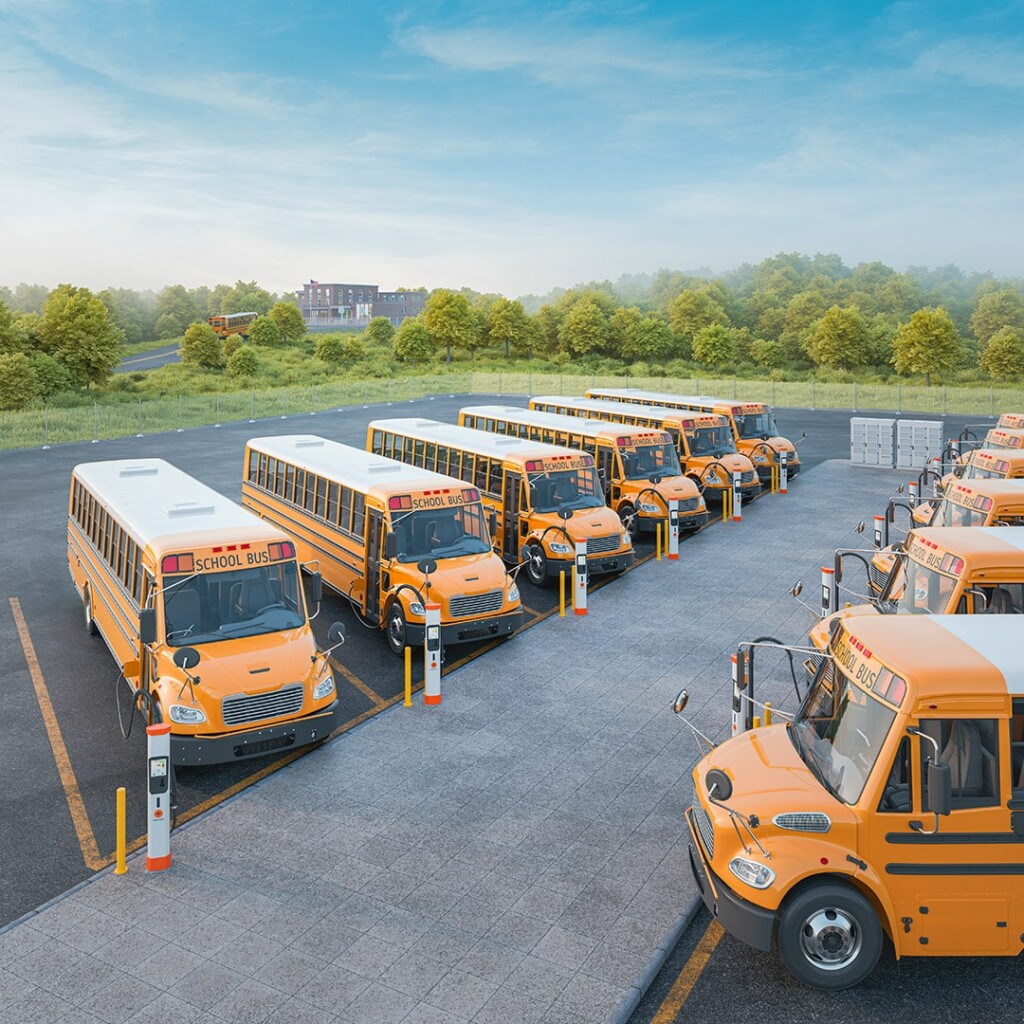Electric School Buses Move Everyone Forward
Want to know where the next big EV boom is taking place? Try the nearest school bus stop in your neighborhood.
Electric school buses (ESBs) are growing in popularity all over the U.S. and North America, and for good reason — actually, for several.
ESBs are healthier for students, better for the environment, and offer a lower total cost of ownership (TCO) than diesel buses over both vehicles’ lifetimes.
When you factor in that the federal government and state legislatures are making it far more cost-effective to invest in ESBs and the infrastructure needed to support them with programs like the Clean School Bus Rebate Program, it’s no wonder that more and more school districts are electrifying their fleets.
Currently, 54 states and U.S. territories either have electric school buses on the road or are in the process of acquiring them. Multiple states have mandatory zero-emission statutes that require the electrification of school buses in the coming years.
So, the question for school district decision-makers isn’t whether they should electrify their fleet; it’s when? The benefits of ESBs and current funding opportunities are just too significant to ignore.
Moving Forward Quickly (and quietly):
The Case For Electric School Buses.
Making a positive impact on the planet and preserving the health and well-being of students are the most obvious benefits of ESBs. But they aren’t the only ones. There are additional advantages that make ESBs an even more practical and progressive choice for school districts and the bus contractors that supply them.
Why Electrify?
Less Pollution, Cleaner Planet
Electric school buses emit less than half as many greenhouse gases as diesel and propane-powered buses.
*(World Resources Institute, The State of Electric School Bus Adoption In The US, Freehafer, Lazer, Zepka)
Less Pollution, Healthier People
Consistent exposure to diesel pollution contributes to asthma and other respiratory diseases. ESBs have no tailpipe emissions, so students and bus drivers consistently have healthier air to breathe.
Lower Fuel Costs
Electricity is less expensive than fossil fuel, especially when you can schedule charging for off-peak hours. According to Blue Bird, a leading bus manufacturer, fuel costs for ESBs are about 14 cents per mile compared to 49 cents for diesel-powered buses.

Lower Maintenance Costs
Electric school buses have fewer actual parts than diesel buses. Fewer parts mean fewer parts to fix, which results in lower maintenance costs over the long term.
Lower Lifetime Costs
Electric school buses are more expensive than diesel-powered buses…at first. But, according to the Environmental Defense Fund, ESBs make up for their higher sticker price with much lower long-term fuel and maintenance costs. When the final results are tabulated, an ESB’s total cost of ownership (TCO) is lower than a diesel bus’s.
According to the Electric School Bus Initiative, a school district operating an electric school bus can expect over $100,000 in lifetime fuel and maintenance savings compared to an equivalent diesel-powered bus.
Ample Funding Opportunities
Thirty-nine percent of all committed electric school buses in the US were purchased with rebates from the EPA’s Clean School Bus Rebate Program. This federal initiative will award five billion dollars over five years (2022 – 2026) to help school districts purchase electric school buses and set up charging infrastructure.
Infrastructure Planning and Solutions
Before purchasing electric school buses, you must identify the best way to charge them. Selecting the right charging infrastructure is critical to access all the advantages ESBs have to offer.
The following are key factors stakeholders must consider when evaluating an electric school bus charging site and infrastructure.
Slow and Fast-Charging Flexibility
Since school bus routes and daily mileage are predictable, and school buses themselves are inactive for the majority of most days, it’s reasonable to do the vast majority of ESB charging during off-peak hours when rates are lowest.
Overnights are ideal since charging is done at low power over several hours, which maximizes efficiency and minimizes expense. However, when field trips and long, after-school sports trips come into play, which happens frequently, the ability to charge buses quickly during the day with DC (direct current) power becomes vital.
Therefore, it’s important to have charging equipment that’s versatile and powerful enough to serve both slow and fast-charging needs daily.
Dynamic Charging
A dynamic power routing system disperses electricity proportionally based on need. ESBs that travel the greatest distances and, therefore, need the most electricity to charge will get that additional power redirected to them automatically once the
less-traveled ESBs are full. Dynamic charging ensures that your electricity use is optimized consistently.
Data-Driven Decisions
Access to real-time data ensures that you can keep your charging infrastructure and buses running at peak performance levels. Smart software like Kempower’s ChargEye offers actionable insights into essential data points like charging schedules and power usage.
CONCLUSION
ESBs:
Coming to a bus stop near you.
When you compare the benefits of an electric school bus to its diesel-powered counterpart, well, there really is no comparison:
- ESBs are healthier for the kids who ride them, the communities they travel through, and the planet we all share.
- ESBs offer lower fuel and maintenance costs than diesel buses, which gives them a lower total cost of ownership over the lifetime of both vehicles.
- While ESBs have a higher sticker price than diesel buses, the abundance of federal and state funding programs goes a long way toward minimizing the upfront costs.
- The ease and innovation of charging infrastructure make an electrified fleet easy to manage and maximize.
While the decision to switch to electric school buses is significant, it’s also easy to understand why more school districts are choosing to electrify. State legislatures are helping to build the momentum.
Since 2022, five states have enacted zero-emission school bus mandates. Delaware is requiring that 30% of new buses be electric by 2030. Colorado, Michigan, and Washington D.C. aim for 100% of all school bus sales to be electric within that same timeframe. It’s only a matter of time before other states follow suit.
Currently, most school buses on the road are still diesel-powered. That means you can still hear the school bus coming long before you actually see it in most neighborhoods. But with the growing interest in and acquisition of ESBs, plus the financial commitment made by the federal and state governments to support the movement, it seems safe to say that quieter, cleaner, and healthier mornings are on the way. The buses we’ve all been waiting for will be here soon.

Written by
Jed Routh
Vice President, Markets & Products
